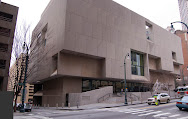***


***
Max Eternity - Moments ago I had a chance to chat with Brenda Galina, Director of the
Museum of Design Atlanta (MoDA). Along with Architects Institute of America - Atlanta, the Atlanta Public Library System and others, Galina and MoDA have been largely responsible for the fruition of one of the brightest exhibition achievements in the recent history of Atlanta's museum scene--the Marcel Breuer Retrospective. (All images courtesy of
Vitra Design Museum)
_________________________
________
____

Marcel Breuer 1902 - 1981
_____________________________________
Max Eternity (ME): Brenda, thanks for taking the time to chat with me.
Brenda Galina (BG): It's my pleasure.
ME: So, first I'd like to ask a simple but important question, what's the role of artistic institutions?
BG: I think it's probably a lot of roles. there's one that comes to mind--to bring to the public their specific form of artistic endeavor...what ever that is. It's to showcase the finest of what they can create, also educating the public about what good architeture and sculpture is. These things enhance the quality of life for the public.

ME: How would you describe your experience with the Breuer exhibition, what's the response so far?
BG: I think people that have seen the exhibit, folks that aren't architects of historians, are really impressed. People are really just surprised to see these original pieces, especially the chairs.
As well, most people are stunned by the architecture, because so many don't realize what a modernist Breuer was at the time. So they are pleasantly surprised by how timeless Breuer was--his work.

ME: If lessons are to be learned by Breuer, what is it that he has taught us from a design perspective and as ordinary citizens?
BG: It's the same answer almost, because good design is lasting. Nobody will argue that his was expert design. And when you look at it today, it's as current as it was 50 years ago.
ME: With that in mind, what would you say is the role of a museum when it comes to cultural heritage?
BG: Well, I think [pause] it's to bring an awareness to the public of the magnitude of the Central Library, for instance. So, I think it's all just a matter of pointing out to the public the merits of good architecture and design.
ME: Is architecture art? I ask, because I've had this discussion with some, who seem to think that architecture is not art, because of its utilitarian nature. Others however say, yes, it is art. What's you view on this?
BG: I think good architecture is art. There's nothing more beautiful than seeing a beautiful building.
ME: So beyond the Breuer experience, what's the mission of MoDA, and are there any future development we should be aware of?
BG: MoDA's vision has always been to bring excellent design to the public eye. We're constantly seeking good design. And I think Marcel Breuer is one of the biggest names. This is one of the top exhibitions we've ever had.
Architecture is an important part of our programming. And next year, Februrary, we have our traveling show "Beyond Sticks and Bricks." The exhibit spotlights many of Atlanta's outstandig design examples, as the entire focus is to help the public to understand what it might mean to be "Green" while also giving them the tools to make a difference. This can help to raise an awareness about what living, working and playing in the Atlanta area can be--beyond the architectural significance, while also telling the story of individuals in various environments and locals.
ME: Brenda, I look forward to it.
BG: Thanks Max.
- Click here to visit the Museum of Design Atlanta-




.jpg)































